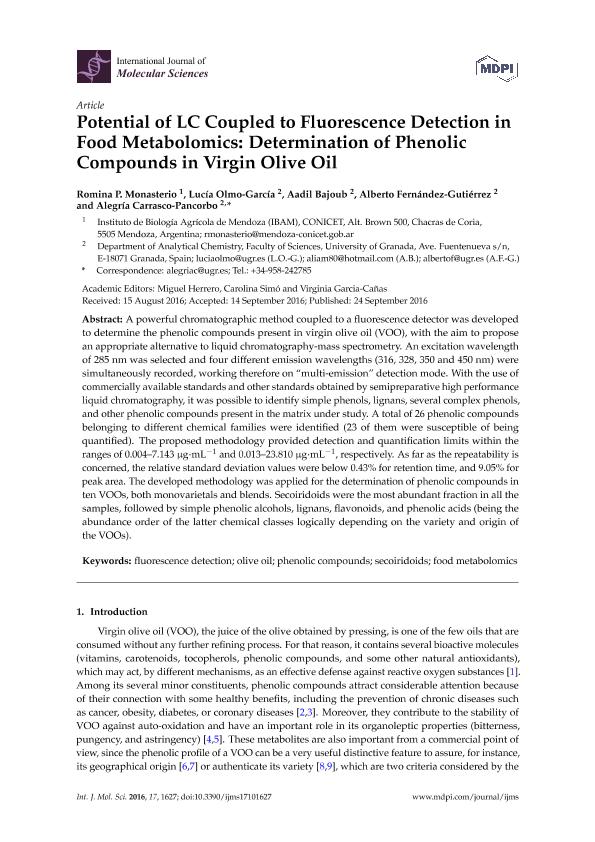Mostrar el registro sencillo del ítem
dc.contributor.author
Monasterio, Romina Paula

dc.contributor.author
Olmo García, Lucía

dc.contributor.author
Bajoub, Aadil
dc.contributor.author
Fernández Gutiérrez, Alberto
dc.contributor.author
Carrasco Pancorbo, Alegría

dc.date.available
2017-09-07T17:02:43Z
dc.date.issued
2016-09-24
dc.identifier.citation
Monasterio, Romina Paula; Olmo García, Lucía; Bajoub, Aadil; Fernández Gutiérrez, Alberto; Carrasco Pancorbo, Alegría; Potential of LC coupled to fluorescence detection in food metabolomics: Determination of phenolic compounds in virgin olive oil; Molecular Diversity Preservation International; International Journal of Molecular Sciences; 17; 10; 24-9-2016; 1-17
dc.identifier.issn
1422-0067
dc.identifier.uri
http://hdl.handle.net/11336/23769
dc.description.abstract
A powerful chromatographic method coupled to a fluorescence detector was developed to determine the phenolic compounds present in virgin olive oil (VOO), with the aim to propose an appropriate alternative to liquid chromatography-mass spectrometry. An excitation wavelength of 285 nm was selected and four different emission wavelengths (316, 328, 350 and 450 nm) were simultaneously recorded, working therefore on "multi-emission" detection mode. With the use of commercially available standards and other standards obtained by semipreparative high performance liquid chromatography, it was possible to identify simple phenols, lignans, several complex phenols, and other phenolic compounds present in the matrix under study. A total of 26 phenolic compounds belonging to different chemical families were identified (23 of them were susceptible of being quantified). The proposed methodology provided detection and quantification limits within the ranges of 0.004-7.143 g/mL and 0.013-23.810 g/mL, respectively. As far as the repeatability is concerned, the relative standard deviation values were below 0.43% for retention time, and 9.05% for peak area. The developed methodology was applied for the determination of phenolic compounds in ten VOOs, both monovarietals and blends. Secoiridoids were the most abundant fraction in all the samples, followed by simple phenolic alcohols, lignans, flavonoids, and phenolic acids (being the abundance order of the latter chemical classes logically depending on the variety and origin of the VOOs).
dc.format
application/pdf
dc.language.iso
eng
dc.publisher
Molecular Diversity Preservation International

dc.rights
info:eu-repo/semantics/openAccess
dc.rights.uri
https://creativecommons.org/licenses/by-nc-sa/2.5/ar/
dc.subject
Fluorescence Detection
dc.subject
Olive Oil
dc.subject
Phenolic Compounds
dc.subject
Secoiridoids
dc.subject
Food Metabolomics
dc.subject.classification
Otras Ciencias Químicas

dc.subject.classification
Ciencias Químicas

dc.subject.classification
CIENCIAS NATURALES Y EXACTAS

dc.title
Potential of LC coupled to fluorescence detection in food metabolomics: Determination of phenolic compounds in virgin olive oil
dc.type
info:eu-repo/semantics/article
dc.type
info:ar-repo/semantics/artículo
dc.type
info:eu-repo/semantics/publishedVersion
dc.date.updated
2017-07-13T17:54:15Z
dc.journal.volume
17
dc.journal.number
10
dc.journal.pagination
1-17
dc.journal.pais
Suiza

dc.journal.ciudad
Basel
dc.description.fil
Fil: Monasterio, Romina Paula. Consejo Nacional de Investigaciones Científicas y Técnicas. Centro Científico Tecnológico Conicet - Mendoza. Instituto de Biología Agrícola de Mendoza. Universidad Nacional de Cuyo. Facultad de Ciencias Agrarias. Instituto de Biología Agrícola de Mendoza; Argentina
dc.description.fil
Fil: Olmo García, Lucía. Universidad de Granada. Facultad de Ciencias. Departamento de química analítica; España
dc.description.fil
Fil: Bajoub, Aadil. Universidad de Granada. Facultad de Ciencias. Departamento de química analítica; España
dc.description.fil
Fil: Fernández Gutiérrez, Alberto. Universidad de Granada. Facultad de Ciencias. Departamento de química analítica; España
dc.description.fil
Fil: Carrasco Pancorbo, Alegría. Universidad de Granada. Facultad de Ciencias. Departamento de química analítica; España
dc.journal.title
International Journal of Molecular Sciences

dc.relation.alternativeid
info:eu-repo/semantics/altIdentifier/url/http://www.mdpi.com/1422-0067/17/10/1627
dc.relation.alternativeid
info:eu-repo/semantics/altIdentifier/doi/http://dx.doi.org/10.3390/ijms17101627
Archivos asociados
